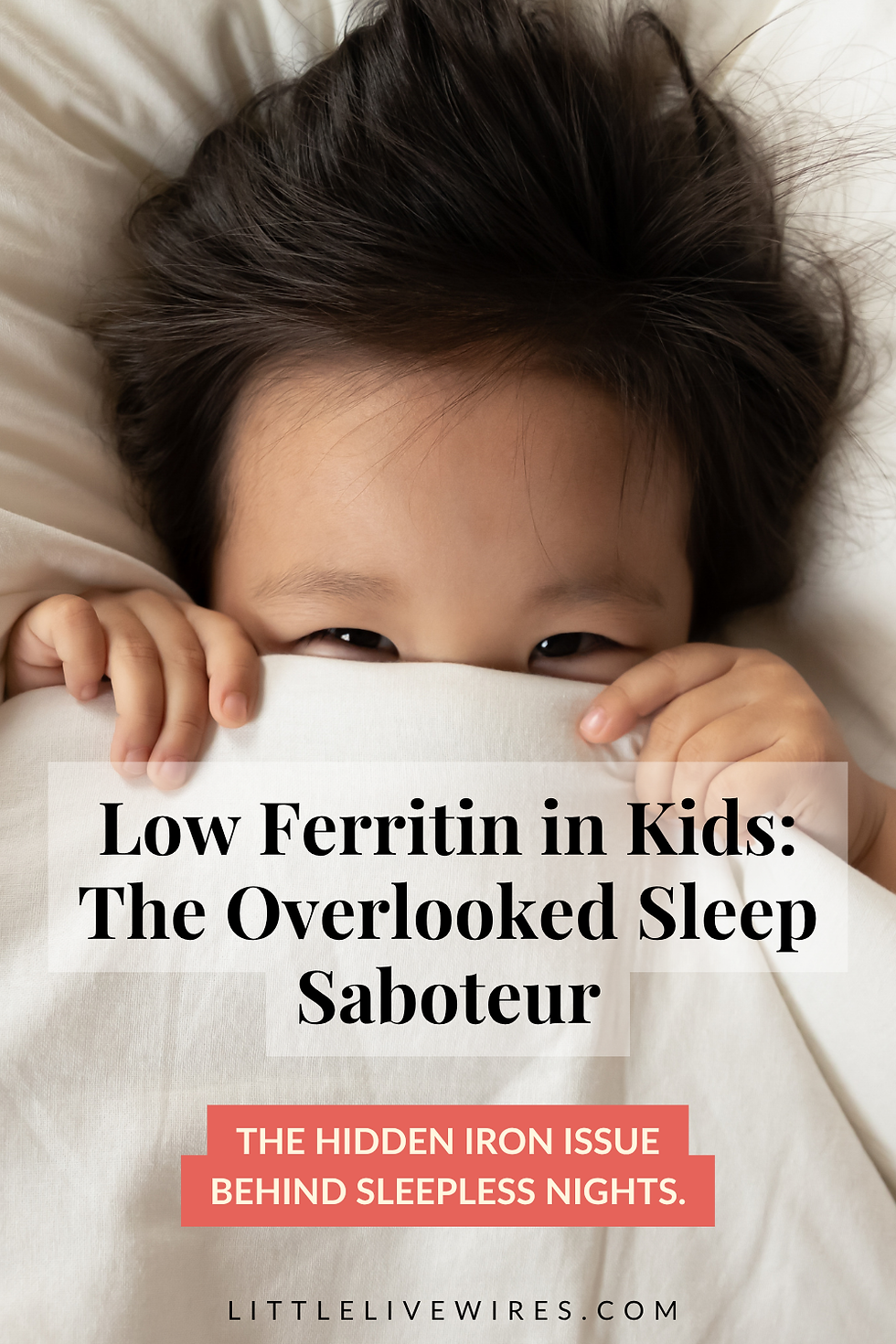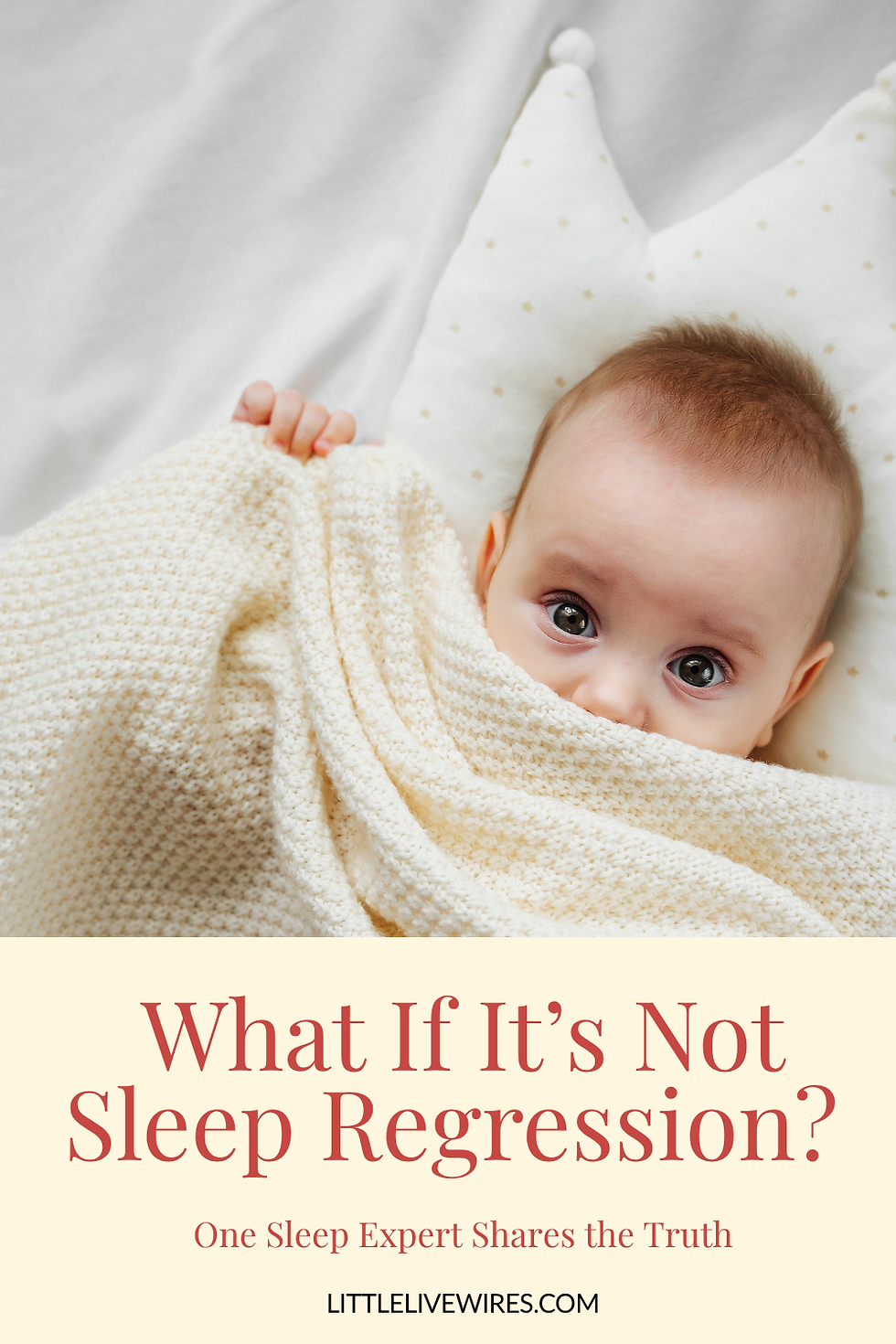Low ferritin: The little-known reason for chronic sleep issues in young children
- Macall Gordon, M.A.

- Jul 24
- 9 min read
Updated: Nov 19
Important caveat before I start: I am not a doctor. I was trained in this topic by a pediatric sleep doctor/pulmonologist and have read the research, but this is not medical advice and is not meant to diagnose a condition. Please consult with your medical provider or a local pediatric sleep clinic for any concerns about low ferritin and sleep.
As a sleep coach, I often see clients only after they have tried everything under the sun and are still struggling. Because I specialize in trying to solve more complex sleep problems, I have also seen a surprising number of clients with really severe issues that do not seem behavioral in nature.
One client had a toddler who was awake from 12-5 a.m. every night and only wanted mom to stand up and hold him with his legs dangling down. Every time she even tried to sit down, he screamed.
Another client had a three-year-old who was bouncing off the walls at bedtime (would not lie down), taking over an hour to go to sleep, and was also awake from 2-5 a.m. every night. When they finally would cosleep, the parents reported being pummeled by repeated kicks while he was still asleep.
Another client said that the only way they could get their preschooler back to sleep at night was to put them in the car and drive around.
All of these parents had tried sleep training, but the sleep problems just worsened over time to a point where it felt so much worse than “just behavior” would explain.
ritin and sleep in children

Low Ferritin and Sleep Problems in Young Children
The culprit in each of these cases was low ferritin, which can cause pediatric Restless Legs Syndrome. Currently, diagnostic criteria prevent RLS from being assessed in children younger than 6 or 8 years. It does not mean it’s not happening. Some researchers are increasingly calling for greater attention to earlier diagnosis and treatment of RLS (Al-Shawwa et al., 2022; Leung et al., 2020; Tilma et al., 2013).
Ferritin refers to the iron storage capacity in the blood. This is different from the amount of iron in the blood. Individuals can have sufficient iron, but if it’s not absorbed or stored, the body is less able to utilize it. Babies receive ferritin in utero, as well as a significant dose at birth, which gradually decreases over the first six months. Exclusively breastfed babies are supposed to receive iron supplementation by four or six months. Some infants start out with lower levels of ferritin. Maternal low iron during pregnancy, early cord clamping, silent reflux/food intolerance, or other factors can alter how much ferritin a child has. Over time, levels tend to drop.
Iron levels are usually tested by pediatricians at 9 or 12 months. However, this test is not an adequate indicator of ferritin levels. Iron levels can be normal, even when ferritin is really low.
Levels of ferritin that cause RLS-like symptoms are higher than those considered “iron deficient.” Symptoms of RLS resemble significant bedtime and/or middle-of-the-night discomfort, similar to Restless Legs Syndrome.
Older children with RLS will tell you that their legs feel “twitchy” or “jumpy,” or they feel “nervous" or “scared,” and they can’t get comfortable. Dr. Lewis Kass, pediatric sleep doctor, suggests that much of what we used to call “growing pains” is now thought to be a possible symptom of low ferritin.
Behaviors that stem from RLS can masquerade as garden-variety bedtime protests. We think a child just can’t settle or is bouncing off walls to stall, but in fact, they are really and truly desperately uncomfortable. I can tell you that all three of those clients from above came back with very low ferritin levels, and once the levels started to rise, sleep problems virtually disappeared.
Symptoms
Low ferritin can occur in even very young children. We are more familiar with the symptoms of older children because they can tell us what’s bothering them. In infants and toddlers, we only have behaviors to go on. While currently RLS is primarily diagnosed in older children, research has shown that in most of those cases, symptoms began in infancy and toddlerhood.
[Older children] They will say their legs feel “jumpy,” “tickly,” “prickly,” or that they hurt. (They may say they feel "nervous" or "scared")
They take a long time (more than an hour) to go to sleep at bedtime. They want to be rocked, then not rocked. They want covers, then no covers. It seems like they just can’t get comfortable.
Kicking, thrashing, wanting legs up on something to sleep.
Lots of movement even when they're asleep. (Parents who resort to cosleeping will report that the child needs to sleep ON them or that there's so much movement that they have bruises or can't sleep because their child is moving so much.)
There is a long wakeup (an hour or more) in the middle of the night. It will also seem like nothing works reliably to get them back down.
A wide variety of behavioral strategies haven't worked...at all.
The child wakes at night moaning, screaming, or crying, or they do this in their sleep.
For infants, extreme difficulty with anything but full body contact, constant nursing, etc. (i.e., baby screams if nursing stops or parent tries to move away), kicking/thumping legs (Bruni et al., 2015)
Breath-holding spells (Hamed et al., 2018)
Risk factors
Mom had low iron or Restless Legs Syndrome in pregnancy
There was early cord clamping at birth (babies get a dose of ferritin at birth) (Ceriani Cernadas et al., 2010)
Family history of low iron/ferritin or Restless Legs Syndrome (I talked to one dad who didn't realize he had RLS until we started talking about it.
Child has (or had) silent reflux, eczema, or food intolerance (cow's milk, soy, etc.). These can cause gut inflammation that hinders iron absorption.
[Older children] Diagnosed or suspected ADHD or ASD. It's estimated that 50-75% of children with ADHD (and autism) have low ferritin levels (Kanofal et al., 2007; Kanofal et al., 2004).
Testing
Ferritin can be tested with a simple blood draw (I know, I know. That’s actually not that simple.) Results should come back quickly. Pediatricians' usual lower threshold for “normal” ferritin (<7µg) is considered too low when it comes to sleep. Sleep doctors generally want the score to be above 50µg. If your child is experiencing significant sleep issues and the score comes back as “normal,” get the actual number and then consult a pediatric sleep specialist for assessment and treatment.
Here's another wrinkle. Pediatricians will often suggest testing hemoglobin (which is just a usual finger stick). If hemoglobin is low, chances are that ferritin is also low, but hemoglobin can be normal even when ferritin is low. The body technically goes through ferritin first, then it starts working through hemoglobin. Some researchers contend that anemia is a late-stage indicator of iron deficiency and that we should be testing for ferritin earlier (Georgieff, 2017).
A regular, standard iron test won't tell you what you need to know.
Also, be sure that they actually test ferritin. I've seen parents get a whole blood panel done and ferritin wasn't tested.
Treatment
Treatment for low ferritin typically involves prescription-level iron supplementation (i.e., multivitamins with iron or iron-rich foods are usually insufficient). Doctors typically need to oversee the dosage, etc., because incorrect iron dosing can be dangerous.
Ferritin levels, unfortunately, may take several months to reach the higher threshold. However, you should see improvement in sleep behaviors before that time. In the meantime, stretching or leg massages can work at bedtime. Mild heat can also help symptoms. The good news is that once levels start to rise, you should see massive differences. The toddler in my client examples went from needing to be put in the car to go back to sleep to walking to his bed, getting in, and sleeping through the night.
If you feel like your child’s sleep behavior is more extreme than just a behavioral issue, get their ferritin checked.
Do you have more questions or need to discuss your situation? I have a thirty-minute call where we can discuss low ferritin to see if this fits. Book a low-ferritin call.
Have you been through the low ferritin journey? Willing to share some of this information? I’m collecting some anecdotal data to share with researchers to raise awareness. Fill out my short survey here.
Frequently Asked Questions about Low Ferritin
Can my baby have low ferritin?
The ferritin that babies get before and during birth should sustain them for at least the first 4 to 6 months. Plus, trying to get the okay for a blood draw on an infant isn’t easy. However, it does happen that some infants are low on ferritin. I had one client with an 8-month-old who tested with a ferritin of 1. I usually only recommend testing infants when we have totally ruled out every other possibility, and sleep is just truly awful. In this case, I honestly recommend booking a call with me to help you figure this out.
Can I just offer a multivitamin or iron drops myself?
If ferritin is truly low, an over-the-counter dose won’t hurt, but it also won’t bring levels up. You could waste precious time. Ferritin plays a crucial role in nervous system development. Plus, the fractured and disrupted sleep that’s happening isn’t great for your child (or your family). I usually tell parents to start an over-the-counter supplement while they’re waiting to get a test or prescription. DO NOT give your child more than the recommended dose of iron without a doctor's prescription.
I’ve heard that oral iron doesn’t always work. What then?
This is true. If a child has significant gut inflammation or for other reasons, some children do not absorb iron well and may actually require IV iron. I believe this isn’t the norm, but it does happen. This is why parents need to get a test to see how low ferritin is, and then they need to get seen by a pediatric sleep doctor or other specialist so that levels are monitored over time.
References
Al-Shawwa, B., Sharma, M., & Ingram, D. G. (2022). Terrible twos: Intravenous iron ameliorates a toddler’s iron deficiency and sleep disturbance. Journal of Clinical Sleep Medicine, 18(2), 677–680.
Bruni, O., Angriman, M., Luchetti, A., & Ferri, R. (2015). Leg kicking and rubbing as a highly suggestive sign of pediatric restless legs syndrome. Sleep Medicine, 16(12), 1576–1577. https://doi.org/10.1016/j.sleep.2015.07.016
Ceriani Cernadas, J. M., Carroli, G., Pellegrini, L., Ferreira, M., Ricci, C., Casas, O., Lardizabal, J., & Morasso, M. D. C. (2010). [The effect of early and delayed umbilical cord clamping on ferritin levels in term infants at six months of life: A randomized, controlled trial]. Archivos Argentinos de Pediatria, 108(3), 201–208.
Dosman, C., Witmans, M., & Zwaigenbaum, L. (2012). Iron’s role in paediatric restless legs syndrome: A review. Paediatrics & Child Health, 17(4), 193–197. https://doi.org/10.1093/pch/17.4.193
Georgieff, M. K. (2017). Iron assessment to protect the developing brain. The American Journal of Clinical Nutrition, 106(Suppl 6), 1588S-1593S. https://doi.org/10.3945/ajcn.117.155846
Hamed, S. A., Gad, E. F., & Sherif, T. K. (2018). Iron deficiency and cyanotic breath-holding spells: The effectiveness of iron therapy. Pediatric Hematology and Oncology, 35(3), 186–195. https://doi.org/10.1080/08880018.2018.1491659
Konofal, E., Cortese, S., Marchand, M., Mouren, M.-C., Arnulf, I., & Lecendreux, M. (2007). Impact of restless legs syndrome and iron deficiency on attention-deficit/hyperactivity disorder in children. Sleep Medicine, 8(7–8), 711–715.
Konofal, E., Lecendreux, M., Arnulf, I., & Mouren, M. C. (2004). Iron deficiency in children with attention-deficit/hyperactivity disorder. Archives of Pediatrics & Adolescent Medicine, 158(12), 1113-1115.
Leung, W., Singh, I., McWilliams, S., Stockler, S., & Ipsiroglu, O. S. (2020). Iron deficiency and sleep - A scoping review. Sleep Medicine Reviews, 51, 101274.
Muhle, H., Neumann, A., Lohmann-Hedrich, K., Lohnau, T., Lu, Y., Winkler, S., Waltz, S., Fischenbeck, A., Kramer, P. L., Klein, C., & Stephani, U. (2008). Childhood-onset restless legs syndrome: Clinical and genetic features of 22 families. Movement Disorders, 23(8), 1113–1121
Peirano, P. D., Algarín, C. R., Chamorro, R. A., Reyes, S. C., Durán, S. A., Garrido, M. I., & Lozoff, B. (2010). Sleep alterations and iron deficiency anemia in infancy. Sleep Medicine, 11(7), 637–642. https://doi.org/10.1016/j.sleep.2010.03.014
Picchietti, D. L., & Stevens, H. E. (2008). Early manifestations of restless legs syndrome in childhood and adolescence. Sleep Medicine, 9(7), 770–781. https://doi.org/10.1016/j.sleep.2007.08.012
Tilma, J., Tilma, K., Norregaard, O., & Ostergaard, J. R. (2013). Early childhood-onset restless legs syndrome: Symptoms and effect of oral iron treatment. Acta Paediatrica, 102(5), e221-6.
About Macall Gordon
Macall Gordon, M.A. has a B.S. from Stanford in Human Biology and an M.A. from Antioch University, Seattle in Applied Psychology. She researches and writes about temperament, sleep, and the gap between research and advice. She is also a certified pediatric sleep consultant working with parents of alert, non-sleeping children. She comes to this work because she had two sensitive, intense children and she didn’t sleep for 18 years.
If you enjoyed this article, Low ferritin: The little-known reason for chronic sleep issues in young children, you might also enjoy:
Pin-it for later: Low ferritin: The little-known reason for chronic sleep issues in young children



.png)









Comments